…and the day came when the risk to remain tight in a bud
was more painful than the risk it took to blossom. –Anais Nin

Copyright © Noella Ballenger
Challenge Yourself Each Time You Go Out to Photograph
I love natural light, so I flipped it and photographed the opposite … artificial light. This was a fabulous display of lights in one yard last Christmas. I wanted my shot to be unusual, so I slowed the shutter down just a bit and zoomed in some. I also was hand holding the camera, so I moved slightly giving the final shot a super look.
Are your images starting to look the same over and over again—same color, same subject, same compositions? Are they lacking the energy and zip to make them look outstanding? Maybe it’s time to adjust your “photographic thinking” (break the old habits as it were) in order to give you and your photos a well needed “face lift”! When you challenge yourself to step out of your “comfort zone” and try a new approach to your photography, you’re firing new brain synapses, and the more you engage and repeat those new things, the stronger the synapses become and the more excited you will get. That will lead to some very pleasing results. You’ll have a wonderfully fresh outlook towards capturing those photos, you’ll feel rejuvenated, your compositional and technical skills will climb, your creativity will reach a higher level, and you’ll see an amazing improvement in your images.
So, what are some of the things that you can try when you want to “recharge your batteries” and get new life into those images? Here are some ideas that might help you do just this very thing.
1. Challenge yourself to photograph that which you think you don’t like.
By accepting this challenge, you may change your ideas and the direction you have always gone.
To get a new perspective, you’re going to review and analyze about 100 of your own images and find out what they have in common.
Make a simple list of photo categories (on paper or in your computer program) such as: horizontal or vertical format, what angle, the subject, lighting, and common elements of design, like color and lines. Now look at each photo and make a mark under each category in which the photo fits.
When you are done, you will probably see that they all have a lot in common.
Now go out with your camera and do the opposite of those. This can be a tough one, but get out of your “comfort zone”! Flip what you’ve seen as a chore into a challenge and a wonderful opportunity to learn and grow photographically.
For example:
The majority of your photos are horizontal. Take vertical images only.
Your angle is typically straight on or from the side. Take them from the top or looking up.
Your subjects are landscapes, trees and flowers. Take photos of people or buildings.
Red is your favorite color. Focus on a new color.
You have now fired new brain synapses, “sharpened your eye” to see things more clearly and expanded your photographic horizons to include things you thought you didn’t like.

Copyright © Noella Ballenger
This shot was taken originally as a horizontal, but I found changing it to a vertical made it more striking and “eye catching”. Always try to challenge yourself to a new perspective on you subject. How can you make it new, fresh and interesting? Changing your angles, moving around or trying different things keeps you excited and can produce wonderful shots.
2. Challenge yourself with visiting new places.
Pick a new location and then turn your adventure into a workshop for yourself. Set up some goals of what you think you want to accomplish and be ready to work on those, but also be open for any unexpected and unplanned opportunities that come your way. Plan to stay in a designated location for at least a couple of hours.
Sometimes when you approach a new and unfamiliar area, you have trouble settling down and feeling comfortable. If you aren’t comfortable, you won’t see clearly, because you are focused inward. So, take a few minutes after you arrive to sit quietly and just observe. Once you begin to discern and focus on your surroundings, you’ll see it with a new perspective and you’ll be on your feet and ready to explore photographically.
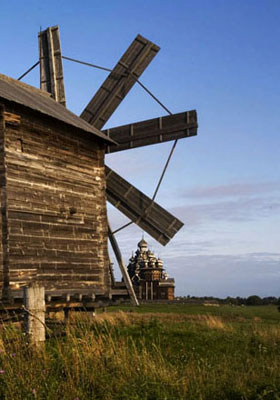
Copyright © Noella Ballenger
Visiting new places is a wonderful experience and while I have been fortunate to be able to visit some far off locations such as seen here (Kizhi Island in Russia), don’t forget that for visitors from other nations our landscapes, parks and city centers are quite unusual and fabulous. And for you here at home in the U.S., take a new tour in and around your own city and town. I’ll bet there is something you haven’t seen or photographed or you’ll find a new way of approaching an old subject.
To read Noella’s travel article series on Finland, Estonia and Russia, just click here.
3. Challenge yourself–less equipment creates new opportunities.
Keep it simple–keep the gear to a minimum. This is the challenge tucked into your camera bag!
Many photographers drag around multiple cameras, lenses, filters, tripods, etc. and then get so focused on picking and choosing that they forget what they were trying to accomplish, miss some special shots or wonder why it’s already time to leave. Force yourself to limit your gear. This will also prepare you for the day when the lens you want doesn’t work or you forgot to bring it.
Try working with only one lens and really work with it. Jim Austin has a wonderful article called “Zoom with your Feet…” and it is a great way to practice your photographic skills and really get to know your equipment. Learn to optimize your equipment by working with one piece at a time until you know how to get just about any shot that you want to get in spite of the equipment you have with you. And this goes for tripods and flash equipment as well. Learn to improvise. No tripod? Well find a wall or a tree for support or set the camera on the ground for a different angle as well as to keep it steady.
The questions are, “Can I get all of the shots I want? If not, can I figure out a way to make it work anyway?” The process will get your creative juices flowing and you’ll walk away with some wonderful, unexpected images.
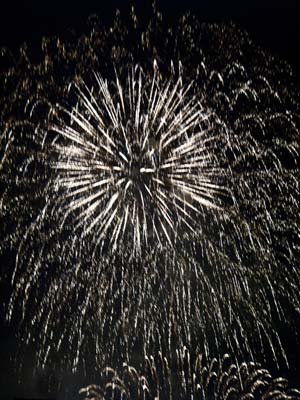
Copyright © Noella Ballenger
The Fourth of July fireworks are a wonderful American tradition and I love watching them. But this year I didn’t feel like dragging along a whole bag of photo gear, so I went light. One camera, one lens and that was it. The shot was a little wider than I wanted it to be, but with some careful cropping in Photoshop, it came out just like I wanted it to look.
4. Challenge yourself with shooting at various times of day and under a variety of conditions.
Raining outside–can’t take any photos in that! Challenge your creative senses! Why not go for abstracts in a blurry car window, shoot from a porch or grab that umbrella, cover yourself and your camera, and take a walk in the rain. What photo treasures can you find?
Or, how about when it is high noon and the light is harsh with crispy shadows…can’t shoot then either? Why not try a little macro photography–it’s great at high noon. And how about a project where you just shoot shadows and not the object? That can be great fun too. Accept the challenge that says, “No you can’t!” and flip it into “Yes I can!”
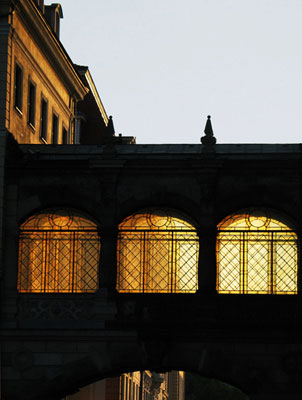
Copyright © Noella Ballenger
I was in Dresden and it was a beautiful summer evening, but I was really tired and almost didn’t go out. Rather than resting, I accepted the challenge to walk around the old town section. I was just enjoying my time when I looked up and saw this enclosed bridge between two buildings. The light was breathtaking and I was so pleased that I took that challenge and found this special view.
5. Challenge yourself with reading your camera manual.
Do you know all the “hidden” attributes of your camera? So many of us never really read or want to study our entire camera manual. We want to just set it up to continue shooting the way we always have. For a challenge, break out that camera manual and see what you might have missed. For example, lots of cameras can now shoot video or black and white images. One of my friends and I were chatting about cameras one day and she showed me her little tiny digital camera that she carries when she goes hiking. She handed me the camera, set it on slide show and all of a sudden I was watching the scene pan around on the stills, followed by a video piece with a running stream and then back to the still shots and so on…. It was grand fun and now I want to see if any of my cameras can do that. If they can, you bet I’ll figure out how to do it and how to have fun with it.
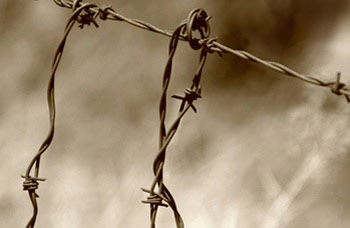
Copyright © Noella Ballenger
Don’t like reading your camera manual? You aren’t the only one, but after the initial setup, I go back to review it on occasion just to see what I’ve missed. I discovered that my camera would allow me to do black and white (monochrome) images as well as sepia toned images right in the camera! Amazing! This barbed wire just begged for the rich sepia tones to give it an “old western” theme.
And since I like to challenge myself with new things, turning to Photoshop was a fun option. I love flowers and that’s what I happened to see in the black and white photo, so I decided to hand colorize parts of the image and bump up the contrast to make it more fun .
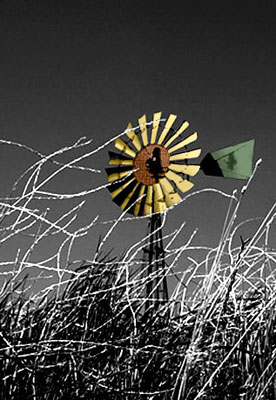
Copyright © Noella Ballenger
6. Challenge yourself by taking new classes.
A great way to expand your abilities and get fresh enthusiasm is to take a class. It doesn’t even have to be a photography class, but perhaps sewing or art or literature–anything that grabs your interest and moves you forward. If you are learning in one area your enthusiasm and quest for information and skills will carry over into your photographic world.
I love teaching photography and as such, have created my own new challenge. I’m putting together a new class for one of my more advanced students. This Independent Photo Study class incorporates the project or venue chosen by the student. It’s an intense student self-directed course, where I guide, challenge and critique her work and try to show her how to cut through the emotional tangle (“but I love that shot” … my words not hers) to learn to self critique effectively. She has chosen as her subject “Street Photography” and we are both excited about this new venture and the opportunities it presents.
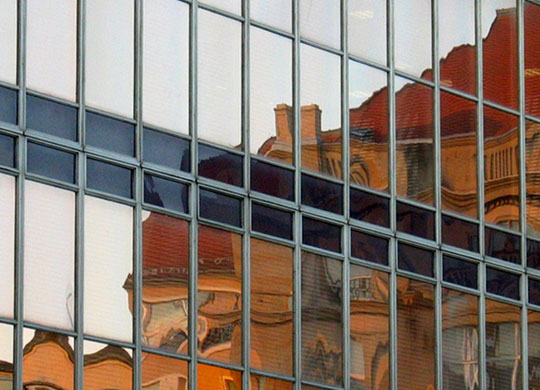
Copyright © Noella Ballenger
I don’t do much photography in my home town, but I accepted a challenge to do more city images since I have an Independent Study student who is doing street photography. I do love architecture and wanted to twist it around to be unusual. The subject of building reflections have caught my eye and it’s turning into a really fun personal project.
7. Challenge yourself with trying new formats.
A year or so ago, I got to play with a friend’s camera that was converted to infrared by removing something in the sensor that normally blocks the infrared waves. It was so much fun that I took one of my older digital SLR cameras and made it into an infrared digital camera as well. I’m just beginning to learn this art form and I’m nuts about it.
The way I approach anything new is to play with it until I feel comfortable and then I get serious. So I took that camera with me on last year’s trip in the Canadian Rockies. Among other things, I was shooting out of the car window as we were driving along–just being silly and playing around. What I discovered was by playing with that infrared camera, I began to “see” better and my regular work improved by leaps and bounds. I stripped away color by photographing with infrared. What I discovered was that I could now see the “bones” of the composition and make changes in some of my compositions in my regular camera and come out with some pretty dramatic and exciting images.
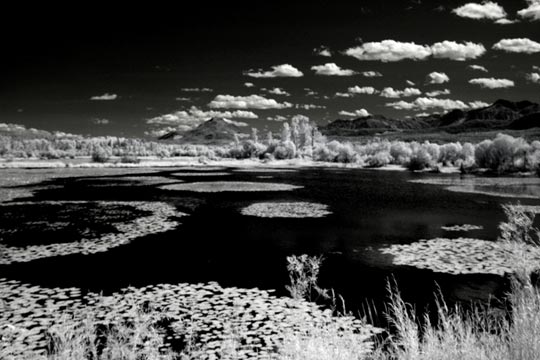
Copyright © Noella Ballenger
These lily pads in the lake we found near RevelstokeNational Park in British Columbia became stepping stones to seeing the general composition of the shot when captured in infrared.
I still don’t know much as much as I would like about infrared, but I will “brush up” on it before my next trip because I won’t leave that camera behind. Also, Apogee Photo has published a couple of articles (found in the archives) and I’ll read those before I leave on my next trip. Who knows, I might even find another new way to challenge myself into making more dynamic and exciting images!
Note: Switching a SLR camera to a digital infrared camera is not inexpensive, but as an alternative, check in your camera’s manual to see if your SLR has a way to shoot black and white images. It won’t be quite the same, but it will help you change your thinking and help you see how to improve your color photographic compositions. Go ahead, give it a try!
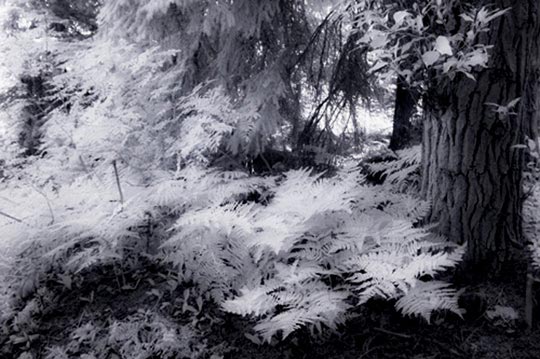
Copyright © Noella Ballenger 2010
The forest floor took on a whole new look when shot with the converted infra red camera. I really like the soft look of the leaves. Learning new skills or new ways of doing things is a challenge, but I’m up for it. Are you?
8. Challenge yourself by creating your own challenges.
Now, step out of your “comfort zone” and challenge yourself. Fire up your brain synapses and get excited again.
One of the ways to do this is by experimentation. Ask yourself the question, “What if I tried ….?”, and then go out and do it. Try doing some “crazy things” with your camera like setting it on time release with a slow shutter speed. Then skip or jump and see what happens. Or find a child or animal that is playing or racing around and work with a slow shutter. Try zooming your lens like a trombone. Break all of the rules of photography you can find by tipping, tilting or shaking you or the camera while you are shooting. There is no one watching, so just relax and have fun.

Copyright © Noella Ballenger
This tall and stately King Penguin was found in the Falkland Islands in the South Atlantic. I’m not sure where he was going, but he had such a stately waddle, you just had to smile. Be prepared for the unexpected when you accept a photographic challenge. You won’t want to miss the shot.
It is not because things are difficult that we do not dare,
it is because we do not dare that they are difficult. – Seneca
The more we respond to our own challenges, the more we will find to explore and the more we find to explore, the more excited we get and the more fun we can have. We live in a wonderful world of creativity but it is our job to find it. Sometimes the “spark” gets turned down or almost turned off. It is at those times, we can reach deep inside of ourselves and bring it back. It takes a little effort and sometimes a lot of perseverance to do this, but it can be done. Take the challenge and then sit back and enjoy watching the quality of your images leap forward.
by Noella Ballenger

Leave a Reply